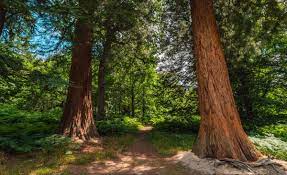Giant redwoods: World’s largest trees ‘thriving in UK’

London: Giant redwoods – the world’s largest trees – are flourishing in the UK and now even outnumber those found in their native range in California.
The giants were first brought to the UK about 160 years ago, and a new study suggests they are growing at a similar rate to their US counterparts.
An estimated 500,000 trees are in the UK compared to 80,000 in California.
However they aren’t yet as tall. In California they can reach 90m-high, but in the UK the tallest is 54.87m.
But that’s because the introduced trees are still very young. Giant redwoods can live for more than 2,000 years, so there’s still plenty of time for the UK’s trees to catch up
“Half a million trees is quite a lot to go under the radar until now, but it’s when you start looking for them in the landscape, and compiling these datasets, that you realise how many there are,” said Dr Phil Wilkes, one of the authors of the study, from Kew’s botanic garden at Wakehurst in Sussex.
Giant redwoods (Sequoiadendron giganteum) were first brought to the UK by the Victorians. They were the ultimate botanical status symbol, typically planted in the grand estates of the wealthy.
Today, some form sweeping avenues while others stand in ones or twos. But they’re easy to spot: their dense, cone-shaped crowns stand proud of everything around them.
To assess how these towering giants are adapting to their UK home, scientists selected a sample of nearly 5,000 trees to study at Wakehurst, Benmore Botanic Garden in Argyllshire, Scotland and Havering Country Park in Essex.
They used laser scanners to measure the heights and volumes of some of the trees – it’s also a way to weigh the trees without cutting them down.
The researchers found that the trees were growing about as fast as the giant redwoods in their native home in the mountains of Sierra Nevada. The UK climate seems to suit them, says Dr Wilkes.
“Where they grow in California, it’s cooler and moister than you would typically envisage California to be,” he explained.
“And we have a reasonably similar climate here – it’s very wet and they need the moisture to grow.”
The scientists also looked at how much carbon dioxide the trees were absorbing – trees soak up and store the greenhouse gas and planting more trees can play a role in helping to tackle climate change.
The researchers found that because of their sheer size, giant redwoods can lock up large amounts of carbon dioxide in their wood – although not as much as their US counterparts.
The trees at Wakehurst, which are about 45m tall, have about 10 to 15 tonnes of carbon stored in them, Dr Wilkes explained.
“But compare this to the largest tree in California, which has about 250 tonnes of carbon stored in it, and they’re quite small. But you know, these could get as big.”
The scientists involved in the research are quick to point out that planting forests of giant redwoods would not be enough to significantly reduce the amount of carbon dioxide in the atmosphere. But these majestic giants can play a part in a mixed forest plantation with a variety of other trees, both native and imported.
In California, the natural wonders are under threat from climate change – they’re not faring well with hotter and drier weather and more intense wildfires.
In an avenue of trees originally planted as a grand entrance to a now demolished mansion in Havering Country Park, Prof Mat Disney, from University College London, says he thinks it’s more than possible.
“In terms of climate, it’s probably the case that they’re going to have a less pressured existence here than they do in California,” he said.
Although he pointed out that conditions are also changing in the UK with climate change.
Giant redwoods are being planted as saplings all over the country, often by local authorities in public parks or recreation grounds.
Professor Disney says they have a long life ahead of them – and they won’t stay small for long.
“They’re very fast growing, and they grow large. Once they reach about 60m, they will be the tallest trees in Britain, and then they will keep on growing,” he said.
However, while the trees are doing well in the UK, there’s little chance of them taking over our native forests any time soon – they’re not reproducing here as they need very specific conditions to take seed.





